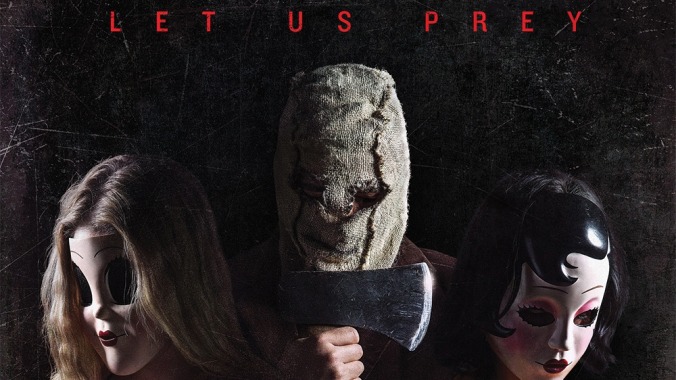The sequel Prey At Night slashes The Strangers’ home-invasion premise into... art?

On a spooky, foggy night, homicidal sadists creep through the vacation-rental community of Gatlin Lake to an ironic soundtrack of ’80s pop (“Kids In America,” “Total Eclipse Of The Heart,” etc.): two women in doll masks and a man in a burlap bag with eyeholes. Their prey are a super-generic nuclear family of four: mom, dad, angsty daughter, jock son. The plot is pure slasher nonsense, from the illogical movement of the tormentors (armed with kitchen knives, axes, awls, and so on) to the even less logical behavior of their victims; it could even be a commentary, a pastiche ad absurdum of contemporary horror’s obsession with quoting Carter and Reagan-era vibes and classic John Carpenter. But the only real problem with Prey At Night, Johannes Roberts’ technically accomplished quasi-sequel to the 2008 home-invasion horror film The Strangers, is that it only has so many characters to kill.
From the opening minutes, it’s obvious that Prey At Night is a more formalist piece of work than its predecessor, with which it doesn’t share much apart from the three masked killers with no motive. The cinematographer is Ryan Samul, best known for his work with Jim Mickle on films like We Are What We Are and Cold In July, so unsurprisingly, the visual values bring to mind a Mickle movie: lighting that looks late 1970s to about mid-1980s, slow-crawling zooms, comparatively little handheld camerawork, split diopters effects. One would be forgiven for initially thinking that the movie is just too studious (the opening credits are even in Albertus) and too enamored of its camerawork. Because the first act of this shortish film (under 80 minutes without credits) is unscary—and not in the way that the average horror movie’s dread-building expository scenes are unscary.
One might even call it boring. After an assured (but non-frightening) prologue that shows the killers prowling around an older couple’s trailer, we are introduced to the family, whose thin characterization is done no favors by Roberts’ stiff, artificial staging and mannerist technique. (The most egregious and striking example is a non-starter of a mother-daughter conversation directed as an extremely long unbroken zoom.) They’re on a road trip to deliver the troubled younger child (Bailee Madison) to a boarding school, with an overnight stay at the empty-in-the-off-season Gatlin Lake, managed by an uncle that the kids only dimly remember. They find a note at the gift shop with a key to one of the many unoccupied rental trailers and settle in to do dull family-conflict stuff.
The older child (Lewis Pullman) likes baseball. The parents (Christina Hendricks, Martin Henderson) seem better developed only because they’re played by more experienced actors. Who knows whether it’s intentional, but the leaden foot-dragging and fake-out jump scares of this first section make the brazen, entertaining slash-for-slasher’s-sake action that follows seem even more like an exercise in audience complicity. We want something bad to happen because we’re bored, and that could also be the motive of the anonymous masked maniacs who’ve been stalking the family ever since they got to Gatlin Lake.
Once the stabbing and chasing begins, Roberts, the British director behind such low-budget horror items as 47 Meters Down and The Other Side Of The Door, delivers variations on every cliché and trope of movie scares—the creaking door, the creepy children’s toy, the crashing car—as he makes kickingly effective use of the camera know-how that felt so misplaced in Prey At Night’s opening stretch. But just as the movie seems to have exhausted its supply of generic guilty pleasures, it ascends to some more operatic and mordant plane of slasher-dom in a wacko sequence that involves the aforementioned “Total Eclipse Of The Heart,” a swimming pool, and a perfectly timed smash zoom.
It’s as though the sadistically minimalist premise of the original Strangers has met its match in an equally irrational stock type: the implausibly dumb slasher victim who never looks over their shoulder, always goes in alone, and keeps losing the phone or the gun or the car keys that could guarantee their survival. The finale is almost abstract, seeming suspiciously like a work of art as it blows from fetishistic, neon-lit violence into a Christine-quoting chase with a truck on fire and straight into what appears to be a critical reading of the end of The Texas Chainsaw Massacre. Maybe this showdown, which pits anonymous killers against characters who might as well be anonymous, even has a moral viewpoint—something about sadism and violence in a vacuum. As with the grindhouse movies of old, it’s hard to tell if it’s intentional.